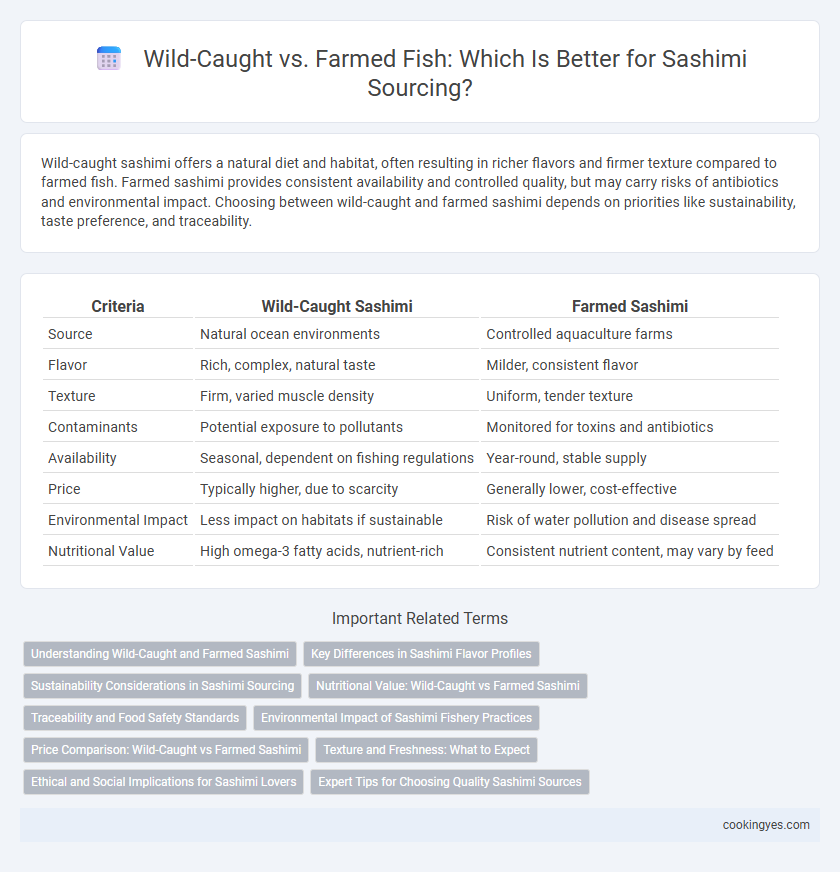Wild-caught sashimi offers a natural diet and habitat, often resulting in richer flavors and firmer texture compared to farmed fish. Farmed sashimi provides consistent availability and controlled quality, but may carry risks of antibiotics and environmental impact. Choosing between wild-caught and farmed sashimi depends on priorities like sustainability, taste preference, and traceability.
Table of Comparison
| Criteria | Wild-Caught Sashimi | Farmed Sashimi |
|---|---|---|
| Source | Natural ocean environments | Controlled aquaculture farms |
| Flavor | Rich, complex, natural taste | Milder, consistent flavor |
| Texture | Firm, varied muscle density | Uniform, tender texture |
| Contaminants | Potential exposure to pollutants | Monitored for toxins and antibiotics |
| Availability | Seasonal, dependent on fishing regulations | Year-round, stable supply |
| Price | Typically higher, due to scarcity | Generally lower, cost-effective |
| Environmental Impact | Less impact on habitats if sustainable | Risk of water pollution and disease spread |
| Nutritional Value | High omega-3 fatty acids, nutrient-rich | Consistent nutrient content, may vary by feed |
Understanding Wild-Caught and Farmed Sashimi
Wild-caught sashimi offers naturally sourced fish with diverse flavor profiles and firm textures due to their ocean habitat and diet, making it highly prized among sushi chefs. Farmed sashimi-grade fish provide consistent quality and sustainability through controlled environments that reduce exposure to pollutants and maintain optimal growth conditions. Understanding these distinctions allows consumers to make informed choices based on taste preferences, environmental impact, and traceability in sashimi sourcing.
Key Differences in Sashimi Flavor Profiles
Wild-caught sashimi features a more complex and robust flavor profile due to the diverse natural diet and active lifestyle of the fish, resulting in firmer texture and richer umami taste. Farmed sashimi tends to have a milder flavor with a softer texture influenced by controlled feeding and environmental conditions, which can sometimes lead to higher fat content and buttery mouthfeel. These differences impact sashimi quality and consumer preference, with wild-caught sashimi often favored for its authentic taste and farmed sashimi valued for consistency and availability.
Sustainability Considerations in Sashimi Sourcing
Wild-caught sashimi sources often offer a more natural flavor profile but can raise concerns about overfishing and ecosystem disruption, impacting long-term marine biodiversity. Farmed sashimi fish, such as salmon or tuna, provide a more controlled and consistent supply while potentially reducing pressure on wild populations; however, sustainability depends on farming practices including feed sourcing, waste management, and disease control. Choosing sashimi from certified sustainable fisheries or responsible aquaculture operations ensures balanced ecological impact and supports ocean conservation efforts.
Nutritional Value: Wild-Caught vs Farmed Sashimi
Wild-caught sashimi typically contains higher levels of omega-3 fatty acids and lower amounts of saturated fats compared to farmed counterparts, enhancing its nutritional profile. Farmed sashimi, while more consistent in quality and availability, may have increased levels of contaminants and a different balance of nutrients due to controlled feeding practices. Choosing wild-caught sashimi supports a richer intake of essential nutrients beneficial for heart and brain health.
Traceability and Food Safety Standards
Wild-caught sashimi fish offers higher traceability due to natural habitats and seasonal catch records, ensuring authentic origin verification. Farmed sashimi sources maintain stringent food safety standards through controlled environments, reducing contamination risks and improving pathogen management. Consumers prioritizing traceability and safety should evaluate certifications and supply chain transparency when choosing between wild-caught and farmed sashimi.
Environmental Impact of Sashimi Fishery Practices
Wild-caught sashimi fish typically has a lower environmental footprint due to natural ecosystems regulating fish populations and reduced resource inputs compared to farmed fish. Farmed sashimi fish production often involves high water usage, feed requirements, and the potential for habitat degradation and pollution from waste runoff. Sustainable sourcing prioritizes wild fisheries with certified management practices to minimize overfishing and protect marine biodiversity.
Price Comparison: Wild-Caught vs Farmed Sashimi
Wild-caught sashimi typically commands a higher price due to limited supply, seasonal availability, and the costs of sustainable fishing practices. Farmed sashimi offers a more consistent, affordable option with year-round availability but may vary in flavor and texture compared to wild-caught counterparts. Market pricing reflects consumer demand for premium quality and sustainability certifications influencing the cost gap between these two sashimi sources.
Texture and Freshness: What to Expect
Wild-caught sashimi offers a firmer texture and complex flavor profile due to the fish's natural diet and active lifestyle, resulting in superior freshness when sourced promptly. Farmed sashimi provides a consistently tender texture with controlled fat content, ensuring predictable quality but sometimes less intense flavor. Freshness in wild-caught sashimi depends heavily on rapid harvest and supply chain efficiency, while farmed sashimi benefits from steady availability and minimized exposure to environmental variability.
Ethical and Social Implications for Sashimi Lovers
Wild-caught sashimi offers a more natural diet and environment for fish, supporting biodiversity and sustainable ocean ecosystems, but risks overfishing and habitat disruption. Farmed sashimi fish provides consistent quality and reduces pressure on wild populations, yet raises concerns over water pollution, disease spread, and animal welfare practices. Sashimi lovers should weigh ethical factors, including environmental impact and social responsibility, when choosing between wild-caught and farmed sources.
Expert Tips for Choosing Quality Sashimi Sources
Wild-caught sashimi offers robust, natural flavors and a diverse nutrient profile, prized by culinary experts for its freshness and texture. Farmed sashimi provides consistent quality and traceability, often sourced from sustainable aquaculture practices that reduce environmental impact. Experts recommend selecting sashimi from reputable suppliers who ensure rigorous safety inspections, transparent origin labeling, and proper handling to guarantee premium taste and optimal freshness.
Wild-caught vs Farmed for sashimi sourcing Infographic

 cookingyes.com
cookingyes.com